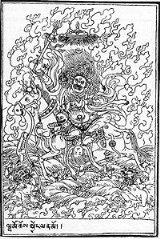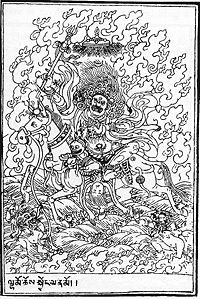
Lhamo La-tso
Encyclopedia
Lhamo La-tso or Lhamo Latso (Tibetan
:ལྷ་མོའི་བླ་མཚོ།, Wylie
: Lha mo bla mtsho), the small oval 'Oracle Lake', is where senior Tibetan monks go for visions to assist in the discovery of reincarnation
s of the Dalai Lama
s. Other pilgrims also come to seek visions. It is considered to be the most sacred lake in Tibet.
It is also known as "The Life-Spirit-Lake of the Goddess", the goddess being Palden Lhamo
, the principal Protectress of Tibet. Other names include: Tso Lhamo (mTsho Lha mo), Chokhorgyelgi Namtso (Chos 'khor rgyal gyi gnam mtsho) and Makzorma (dmag zor ma) and, on old maps, as Cholamo.
 It is said that Palden Lhamo, as the female guardian spirit of the sacred lake, Lhamo La-tso, promised Gendun Drup, the 1st Dalai Lama
It is said that Palden Lhamo, as the female guardian spirit of the sacred lake, Lhamo La-tso, promised Gendun Drup, the 1st Dalai Lama
in one of his visions "that she would protect the reincarnation lineage of the Dalai Lamas." Ever since the time of Gendun Gyatso, the 2nd Dalai Lama, who formalised the system, the Regents and other monks have gone to the lake to seek guidance on choosing the next reincarnation through visions while meditating there.
The particular form of Palden Lhamo at Lhamo La-tso is Gyelmo Maksorma, "The Victorious One who Turns Back Enemies". The lake is sometimes referred to as "Pelden Lhamo Kalideva", which indicates that Palden Lhamo is an emanation of the goddess Kali
, the shakti
of the Hindu
god Siva
.
It was here that in 1935, the Regent, Reting Rinpoche
, received a clear vision of three Tibetan letters and of a monastery with a jade-green and gold roof, and a house with turquoise roof tiles, which led to the discovery of Tenzin Gyatso, the present 14th Dalai Lama
.
, Lhokha to the southeast of Lhasa
, Tibet
, and a four-hour hike from the Gelugpa Chokorgyel Monastery
at an altitude of about 5,300 m. (17,388 ft) and covers an area of only about 2 square kilometre (0.77220431718507 sq mi).
Chokorgyel Monastery
itself is about 115 kilometres (71.5 mi) northeast of Tsetang
and about 160 km (99.4 mi) southeast of Lhasa, at an altitude of 4,500 m (14,764 ft)
The old path from Chokorgyel Monastery used to be paved to make access easier for the senior monks wishing to visit the lake. Half way along is a diamond-shaped pond fed by glaciers known as Yoni
Lake. On a ridge near the top of the pass overlooking the lake a ritual shökde or throne was built for the Dalai Lama, where he once sat to divine the future while gazing into the lake about 1 kilometre (0.621372736649807 mi) in front and 150 metres (492.1 ft) lower down. Nowadays it is buried under a mound of silk scarves (hadak).
Many pilgrims come each year to Lhamo-tso believing that, with proper devoutness, and after fasting for three days and refraining from talk, they will be rewarded with a revelation of their future in the skull-shaped mirror of the lake.
Previously there was a temple to Maksorma (rGyal mo dMag zor ma) or Machik Pelha Shiwai Nyamchen (Ma gcig dPal lh Zhi ba'i nyams can), an unusually peaceful form of Palden Lhamo, at the eastern end of the lake which is now marked only by prayer flags and offerings left by pilgrims.
There is a kora
or pilgrimage walk around the lake.
Tibetan language
The Tibetan languages are a cluster of mutually-unintelligible Tibeto-Burman languages spoken primarily by Tibetan peoples who live across a wide area of eastern Central Asia bordering the Indian subcontinent, including the Tibetan Plateau and the northern Indian subcontinent in Baltistan, Ladakh,...
:ལྷ་མོའི་བླ་མཚོ།, Wylie
Wylie
Wylie may refer to:* Wylie * Wylie , mononymous Aboriginal companion of Edward John Eyre during his crossing of the Nullarbor Plain in Australia* Wylie, Wylie Qua, Access Diving, Gabriola Island, B.C...
: Lha mo bla mtsho), the small oval 'Oracle Lake', is where senior Tibetan monks go for visions to assist in the discovery of reincarnation
Reincarnation
Reincarnation best describes the concept where the soul or spirit, after the death of the body, is believed to return to live in a new human body, or, in some traditions, either as a human being, animal or plant...
s of the Dalai Lama
Dalai Lama
The Dalai Lama is a high lama in the Gelug or "Yellow Hat" branch of Tibetan Buddhism. The name is a combination of the Mongolian word далай meaning "Ocean" and the Tibetan word bla-ma meaning "teacher"...
s. Other pilgrims also come to seek visions. It is considered to be the most sacred lake in Tibet.
It is also known as "The Life-Spirit-Lake of the Goddess", the goddess being Palden Lhamo
Palden Lhamo
Palden Lhamo , Palden Lamo , Shri Devi , or Ukin Tengri is a protecting Dharmapala of the teachings of Gautama Buddha in the Gelug school of Tibetan Buddhism. She is also called Remati...
, the principal Protectress of Tibet. Other names include: Tso Lhamo (mTsho Lha mo), Chokhorgyelgi Namtso (Chos 'khor rgyal gyi gnam mtsho) and Makzorma (dmag zor ma) and, on old maps, as Cholamo.
Oracle or Vision Lake

Dalai Lama
The Dalai Lama is a high lama in the Gelug or "Yellow Hat" branch of Tibetan Buddhism. The name is a combination of the Mongolian word далай meaning "Ocean" and the Tibetan word bla-ma meaning "teacher"...
in one of his visions "that she would protect the reincarnation lineage of the Dalai Lamas." Ever since the time of Gendun Gyatso, the 2nd Dalai Lama, who formalised the system, the Regents and other monks have gone to the lake to seek guidance on choosing the next reincarnation through visions while meditating there.
The particular form of Palden Lhamo at Lhamo La-tso is Gyelmo Maksorma, "The Victorious One who Turns Back Enemies". The lake is sometimes referred to as "Pelden Lhamo Kalideva", which indicates that Palden Lhamo is an emanation of the goddess Kali
Kali
' , also known as ' , is the Hindu goddess associated with power, shakti. The name Kali comes from kāla, which means black, time, death, lord of death, Shiva. Kali means "the black one". Since Shiva is called Kāla - the eternal time, Kālī, his consort, also means "Time" or "Death" . Hence, Kāli is...
, the shakti
Shakti
Shakti from Sanskrit shak - "to be able," meaning sacred force or empowerment, is the primordial cosmic energy and represents the dynamic forces that are thought to move through the entire universe in Hinduism. Shakti is the concept, or personification, of divine feminine creative power, sometimes...
of the Hindu
Hindu
Hindu refers to an identity associated with the philosophical, religious and cultural systems that are indigenous to the Indian subcontinent. As used in the Constitution of India, the word "Hindu" is also attributed to all persons professing any Indian religion...
god Siva
Shiva
Shiva is a major Hindu deity, and is the destroyer god or transformer among the Trimurti, the Hindu Trinity of the primary aspects of the divine. God Shiva is a yogi who has notice of everything that happens in the world and is the main aspect of life. Yet one with great power lives a life of a...
.
- "Lhamo Latso . . . [is] a brilliant azure jewel set in a ring of grey mountains. The elevation and the surrounding peaks combine to give it a highly changeable climate, and the continuous passage of cloud and wind creates a constantly moving pattern on the surface of the waters. On that surface visions appear to those who seek them in the right frame of mind."
It was here that in 1935, the Regent, Reting Rinpoche
Reting Rinpoche
Reting Rinpoche is the title held by abbots of Reting Monastery, a Buddhist monastery in central Tibet. The identity of the present Reting Rinpoche is contested.-History of the lineage:...
, received a clear vision of three Tibetan letters and of a monastery with a jade-green and gold roof, and a house with turquoise roof tiles, which led to the discovery of Tenzin Gyatso, the present 14th Dalai Lama
14th Dalai Lama
The 14th Dalai Lama is the 14th and current Dalai Lama. Dalai Lamas are the most influential figures in the Gelugpa lineage of Tibetan Buddhism, although the 14th has consolidated control over the other lineages in recent years...
.
Geographical setting
The lake is in Gyaca CountyGyaca County
Gyaca County, is a county of the Shannan Prefecture located in the south-east of the Tibet Autonomous Region.Gyatsa County is in the south of Tibet, stretching from the Podrang La pass along the southern side of the Brahmaputra River downstream to Pamda which is just to the southwest of Daklha...
, Lhokha to the southeast of Lhasa
Lhasa
Lhasa is the administrative capital of the Tibet Autonomous Region in the People's Republic of China and the second most populous city on the Tibetan Plateau, after Xining. At an altitude of , Lhasa is one of the highest cities in the world...
, Tibet
Tibet
Tibet is a plateau region in Asia, north-east of the Himalayas. It is the traditional homeland of the Tibetan people as well as some other ethnic groups such as Monpas, Qiang, and Lhobas, and is now also inhabited by considerable numbers of Han and Hui people...
, and a four-hour hike from the Gelugpa Chokorgyel Monastery
Chokorgyel Monastery
Chokorgyel Monastery is a Buddhist monastery in Gyatsa County in Tibet.-History:In 1509 Gedun Gyatso, the 2nd Dalai Lama, had a meditation cave and founded a hermitage here...
at an altitude of about 5,300 m. (17,388 ft) and covers an area of only about 2 square kilometre (0.77220431718507 sq mi).
Chokorgyel Monastery
Chokorgyel Monastery
Chokorgyel Monastery is a Buddhist monastery in Gyatsa County in Tibet.-History:In 1509 Gedun Gyatso, the 2nd Dalai Lama, had a meditation cave and founded a hermitage here...
itself is about 115 kilometres (71.5 mi) northeast of Tsetang
Tsetang
Zêtang is one of the largest cities in Tibet and is located in the Yarlung Valley, 183 km southeast of Lhasa in Nedong County of Lhoka Prefecture, Tibet Autonomous Region of China...
and about 160 km (99.4 mi) southeast of Lhasa, at an altitude of 4,500 m (14,764 ft)
The old path from Chokorgyel Monastery used to be paved to make access easier for the senior monks wishing to visit the lake. Half way along is a diamond-shaped pond fed by glaciers known as Yoni
Yoni
Yoni is the Sanskrit word for the vagina. Its counterpart is the lingam as interpreted by some, the phallus.It is also the divine passage, womb or sacred temple...
Lake. On a ridge near the top of the pass overlooking the lake a ritual shökde or throne was built for the Dalai Lama, where he once sat to divine the future while gazing into the lake about 1 kilometre (0.621372736649807 mi) in front and 150 metres (492.1 ft) lower down. Nowadays it is buried under a mound of silk scarves (hadak).
Many pilgrims come each year to Lhamo-tso believing that, with proper devoutness, and after fasting for three days and refraining from talk, they will be rewarded with a revelation of their future in the skull-shaped mirror of the lake.
Previously there was a temple to Maksorma (rGyal mo dMag zor ma) or Machik Pelha Shiwai Nyamchen (Ma gcig dPal lh Zhi ba'i nyams can), an unusually peaceful form of Palden Lhamo, at the eastern end of the lake which is now marked only by prayer flags and offerings left by pilgrims.
There is a kora
Kora (pilgrimage)
Kora is both a type of pilgrimage and a type of meditation in the Tibetan Buddhist tradition. Kora is performed by making a walking circumambulation around a temple, stupa, or other sacred site. Some traditional kora important to the Tibetan tradition include circumambulating Namtso Lake and...
or pilgrimage walk around the lake.

